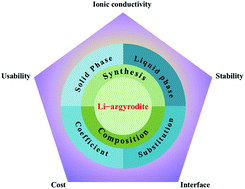Research progress in Li-argyrodite-based solid-state electrolytes
Abstract
Due to the use of liquid electrolytes containing flammable organic solvents, commercial lithium-ion batteries have potential safety issues. All-solid-state lithium batteries (ASSLBs) that utilize solid-state electrolytes (SSEs) are regarded as a secure, next-generation battery system. Significant efforts have been devoted toward developing ASSLBs, but the application of ASSLBs still needs to resolve some scientific and technical problems, such as SSE with high ionic conductivity and stability, technology to reduce interfacial resistance between the electrolyte and electrode, battery design, and large-scale manufacturing technology. The SSE plays a vital role in resolving the above problems and is one of the solutions to achieve the practical application of ASSLBs. Among the many types of SSEs investigated in the past years, Li argyrodite is considered the most promising because of its high ionic conductivity and mechanical properties, and has been investigated in great detail. This article aims to provide a comprehensive review of the research progress in the modification and synthesis of Li-argyrodite-based SSEs, as well as their effects on improvements in ionic conductivity, stability, and interfacial performance. Potential research directions in the development of Li-argyrodite-based SSEs that are commercially feasible in the future are also suggested.

- This article is part of the themed collection: Journal of Materials Chemistry A Recent Review Articles


 Please wait while we load your content...
Please wait while we load your content...